It's-a me again! Mario!
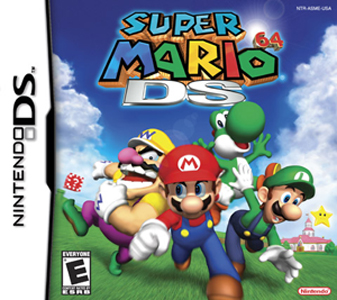
Long before 3D remakes became synonymous with Nintendo's pleasantly popular 3DS system - especially the N64 remake variety - there was another console with a few N64 remakes to call its own, the original DS. Despite it lacking a bit in the horsepower department compared to the N64, the DS was definitely no worse off than the GBA was with its SNES ports some years prior. Probably the only remake anyone remembers today is Super Mario 64 DS, which was a launch title for the fledgling console. It's hard to imagine today, but the DS had a rough start with its then-gimmicky design. It wouldn't be long before it became the big pre-smartphone success story, but without early titles like Super Mario 64 DS, that might have taken a lot longer to happen.
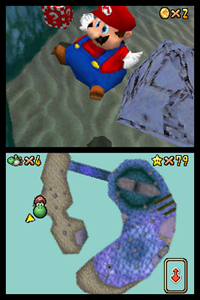
At its core, Super Mario 64 DS is very much like its namesake predecessor, Super Mario 64. The game engine is practically the same, with familiar jumping controls, the same assortment of moves and all the open ended courses you remember. The only significant change I've noticed is an increase in frame rate, up to a usual 30fps. Even if for that reason alone, I don't feel I need to explain the basic controls like in a review of the original. Here we focus on what makes Super Mario 64 DS a good remake, or a bad one.
The first thing anyone will notice is the graphical overhaul. Now, sure this wasn't a 3DS-level remake with Gamecube-like rendering, but Super Mario 64 DS is certainly no slouch in graphics. Although the game probably renders at a slightly lower resolution now, the DS offers incredible texturing compared to what the meager N64 could do. Now the characters of Super Mario 64 look less like plush dolls and more like their common CG renders in Nintendo advertising and packaging. Most of the scenery and objects won't look that much more improved, but the higher detail textures make them look more polished up and more important polygon models like characters and enemies all received more polygons to increase detail. It's a marked step up in quality, but some may feel a bit of Super Mario 64's innocent charm was lost in the upgrade.
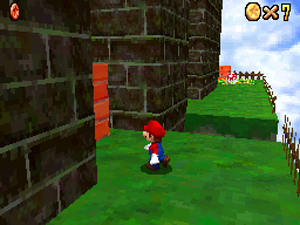
The audio on the other hand isn't nearly as staggering. The DS isn't known to have CD quality sound, nor does Super Mario 64 DS include that much improvement in the music and sound effects. In fact, practically everything sounds the same as in the N64 original. The only difference one may hear is either the DS speaker quality, or possibly a reduction in sample quality. Either way, Super Mario 64 DS faithfully ports over the classic music of the original. Like with the graphics though, higher quality remakes of the original music would have fit nicely.
Speaking of faithfulness, there's one little fact about Super Mario 64 DS most people don't know or remember. The DS doesn't have an analog stick, which Super Mario 64 was originally designed to use, so Nintendo included the option to use the touch screen to move Mario around. When you press on the touch screen, a little circle "target" will appear, showing you a virtual analog stick in the form of a deadzone in the center and a colored ring around it indicating registerable movement. What's especially curious about this functionality is the official Nintendo DS wriststrap includes a plastic cover for your thumb on the end. You would loosen the wriststrap, place the plastic cover under your thumb and then tighten the wriststrap. This is not a particularly great replacement for a physical analog stick, but just the fact Nintendo even included this shows how they managed to think of everything for this early DS title. And no, the 3DS doesn't map the virtual analog stick on the touch screen to the physical circle pad. It just copies the D-pad for original DS games.
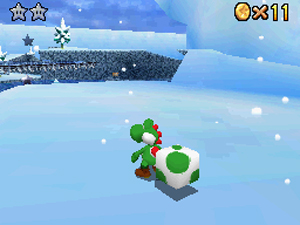
Beyond visual and audio differences, Super Mario 64's biggest claim to fame is the inclusion of additional characters and abilities, along with an additional 30 stars to collect, bringing the total up to 150. Mario is joined by Luigi, Yoshi and Wario in this version. To explain the tacked on characters, the story of Super Mario 64 was altered a bit, with Yoshi being the first playable character. Supposedly, Bowser has captured Mario, Luigi and Wario in Peach's Castle and it's up to Yoshi to free them, along with saving the princess. Well, technically once Mario is unlocked, he becomes the main protagonist again. Mario's original ability hats like the Wing Hat, Metal Hat and Invisible Hat have been given exclusivity for Mario, Luigi and Wario. Yoshi primarily uses transformation hats which actually appear sooner than the real plumbers who do eventually become unlocked. It's especially handy because it means you don't have to return to Peach's room every time you need a different character-specific ability. All that plus 150 power stars is a lot to take in, but makes this a fantastic update to an already excellent Mario game.
In addition to the extra characters, there's an all-new multiplayer mode included. Using the Nintendo DS's wireless connectivity, it's possible to compete for power stars in a few different arenas with your friends. It's certainly a welcome addition to a game that was originally single player only, but it's not necessarily as engrossing as something like Mario Kart or Mario Party, which are primarily multi-player games. Some have said the multi-player in Super Mario 64 DS is an idea originally considered for the original Super Mario 64, and once again for its ill fated sequel, Super Mario 64 2. It's possible, but only Nintendo would really know. Whatever the case, I for one am glad that multiplayer modes were added to Super Mario 64 DS.
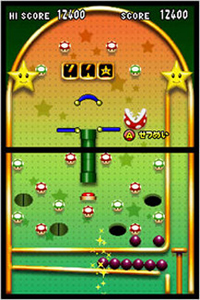
One other notable inclusion is something practically nobody would have expected. Hidden away as unlockables during the main adventure, it's possible to find various mini-games, each themed after the four characters. There is a staggering amount of variety here. Mario's mini-games consist mostly of action games that use the stylus in some way or another. Yoshi's games are puzzle-oriented thinking games, which are an amazingly refreshing distraction from the constant jumping and hopping action of Super Mario 64. Luigi's mini-games are probably the most out-of-place, being primarily casino and betting games. Being able to play Super Mario Slots, Roulette and Poker is fun to be sure, but they're definitely not what I was expecting to see in a Mario game. Lastly, Wario's mini-games are all oddball variety titles. They sometimes depend on luck, other times skill, but most of the time you'll find yourself returning to these games the most. Virtually every mini-game included goes on forever or reaches a pre-determined end, with your best score recorded. Curiously enough, Nintendo did feature some of these mini-games in a future Mario title, New Super Mario Bros. They haven't been heard of since though.
In regards to potential flaws, Super Mario 64 DS is the rare exception where I have significant difficulty in finding things to complain about in it. There is just so much that this remake does right. One possible issue I can think of is the lack of a real analog stick, but Mario 64 is the kind of game that really didn't rely on analog movement to be playable. Now if there was F-Zero X DS, that game would be practically impossible to play properly, even with the touch screen. What also comes to mind is the largely unchanged music and sound effects, which I feel are acceptable. Now, understandably, anyone who read my earlier Ocarina of Time 3D review will surely question my judgement here. Consider that the DS hardware is a lot more primitive than the 3DS, it's not so easy to get great music quality in this case. That and Super Mario 64 DS doesn't stray that far from the original in graphical quality. Recomposing the music doesn't make as much sense when the remake in question isn't vastly overhauled in every other area.
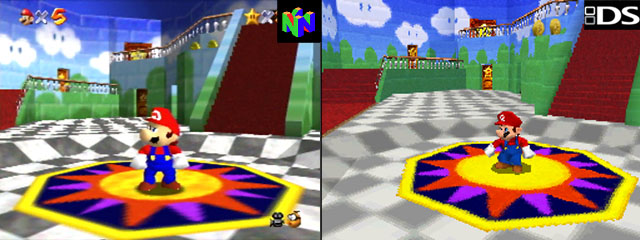
All in all, what could have been a straight and meager port of Super Mario 64 ended up being a wonderfully fantastic improvement. The graphics got a texture overhaul with more polygons, the music is just as good (if not the same), there's more power stars to collect, three additional characters, a multi-player mode and even some random mini-games. I might even dare say, Super Mario 64 DS is better than the original. I know, Super Mario 64 is a classic and the gold standard for 3D platformers, but Nintendo really did an amazing job porting over the original while adding incentive to finish it all over again for people who had played it before. That qualifies Super Mario 64 DS as an excellent remake in my book.
Score (Out of 5):     
Written by Aaron Wilcott
August 26 2015
|